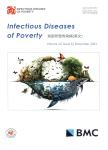Optimal resource allocation with spatiotemporal transmission discovery for efective disease control
作者机构:Department of Computer ScienceHong Kong Baptist UniversityKowloonHong Kong Special Administrative RegionPeople’s Republic of China
出 版 物:《Infectious Diseases of Poverty》 (贫困所致传染病(英文))
年 卷 期:2022年第11卷第2期
页 面:102-103页
核心收录:
学科分类:1004[医学-公共卫生与预防医学(可授医学、理学学位)] 1002[医学-临床医学] 1001[医学-基础医学(可授医学、理学学位)] 100401[医学-流行病与卫生统计学] 10[医学]
基 金:Ministry of Science and Technology of the People's Republic of China, MOST, (2021ZD0112501, 2021ZD0112502) Research Grants Council, University Grants Committee, 研究資助局, (RGC/HKBU12201619, RGC/HKBU12202220)
主 题:COVID-19 Omicron outbreak Densely populated regions Spatiotemporal transmission risk Optimal resource allocation Integrative case management Efective disease control
摘 要:Background:The new waves of COVID-19 outbreaks caused by the SARS-CoV-2 Omicron variant are developing rapidly and getting out of control around the world,especially in highly populated regions.The healthcare capacity(especially the testing resources,vaccination coverage,and hospital capacity)is becoming extremely insufcient as the demand will far exceed the supply.To address this time-critical issue,we need to answer a key question:How can we efectively infer the daily transmission risks in diferent districts using machine learning methods and thus lay out the corresponding resource prioritization strategies,so as to alleviate the impact of the Omicron outbreaks?Methods:We propose a computational method for future risk mapping and optimal resource allocation based on the quantitative characterization of spatiotemporal transmission patterns of the Omicron variant.We collect the publicly available data from the ofcial website of the Hong Kong Special Administrative Region(HKSAR)Government and the study period in this paper is from December 27,2021 to July 17,2022(including a period for future prediction).First,we construct the spatiotemporal transmission intensity matrices across diferent districts based on infection case records.With the constructed cross-district transmission matrices,we forecast the future risks of various locations daily by means of the Gaussian process.Finally,we develop a transmission-guided resource prioritization strategy that enables efective control of Omicron outbreaks under limited capacity.Results:We conduct a comprehensive investigation of risk mapping and resource allocation in Hong Kong,China.The maps of the district-level transmission risks clearly demonstrate the irregular and spatiotemporal varying patterns of the risks,making it difcult for the public health authority to foresee the outbreaks and plan the responses accordingly.With the guidance of the inferred transmission risks,the developed prioritization strategy enables the optimal testing resource allocation for integrative case management(including case detection,quarantine,and further treatment),i.e.,with the 300,000 testing capacity per day;it could reduce the infection peak by 87.1% compared with the population-based allocation strategy(case number reduces from 20,860 to 2689)and by 24.2% compared with the case-based strategy(case number reduces from 3547 to 2689),signifcantly alleviating the burden of the healthcare system.Conclusions:Computationally characterizing spatiotemporal transmission patterns allows for the efective risk mapping and resource prioritization;such adaptive strategies are of critical importance in achieving timely outbreak control under insufcient capacity.The proposed method can help guide public-health responses not only to the Omicron outbreaks but also to the potential future outbreaks caused by other new variants.Moreover,the investigation conducted in Hong Kong,China provides useful suggestions on how to achieve efective disease control with insufcient capacity in other highly populated countries and regions.



